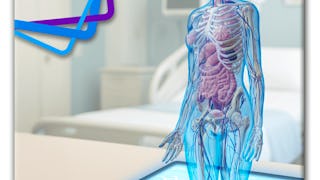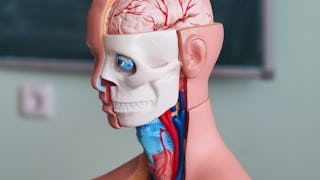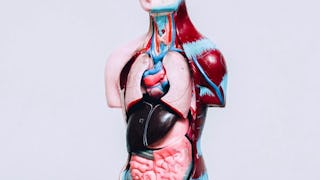This course explores the urinary, nervous, endocrine, reproductive, and integumentary systems, focusing on how they integrate within the body and regulate homeostasis.


Integrating Specialized Body Functions
This course is part of Interactive 3D Anatomy & Physiology: A Gamified Experience Specialization



Instructors: Hilary Gupte
Included with 
Recommended experience
What you'll learn
Learners will explore the structure and functions of the urinary, nervous, endocrine, reproductive, and integumentary systems.
Learners will understand how these systems regulate essential physiological processes and maintain homeostasis.
Skills you'll gain
Details to know

Add to your LinkedIn profile
March 2025
32 assignments
See how employees at top companies are mastering in-demand skills

Build your subject-matter expertise
- Learn new concepts from industry experts
- Gain a foundational understanding of a subject or tool
- Develop job-relevant skills with hands-on projects
- Earn a shareable career certificate

There are 6 modules in this course
In this lesson, learners will explore the structure and functions of the urinary system, including the kidneys, ureters, bladder, and urethra. The role of the kidneys in blood filtration, waste removal, and maintaining homeostasis will be highlighted, with an emphasis on processes such as the function of nephrons, pH regulation, and blood pressure control. Additionally, common urinary system disorders, such as kidney stones, urinary tract infections, and chronic kidney disease, will be discussed to provide context for understanding how dysfunctions in this system can affect overall health.
What's included
5 videos1 reading6 assignments
In this lesson, learners will explore the structure and functions of the male and female reproductive systems, highlighting the roles of key organs such as the testes, ovaries, and uterus. The importance of reproductive hormones, such as testosterone, estrogen, and progesterone, in regulating reproductive processes and maintaining homeostasis will be emphasized, alongside the hormonal feedback mechanisms of the hypothalamic-pituitary-gonadal (HPG) axis. The process of fertilization will be described, demonstrating the intricate coordination required for the union of sperm and egg and subsequent development of a zygote. Finally, the lesson will address common reproductive health disorders, such as endometriosis, polycystic ovary syndrome (PCOS), and infertility, and their impact on overall health and well-being.
What's included
5 videos1 reading6 assignments
In this lesson, learners will explore the structure and functions of the lymphatic system, including its role in maintaining fluid balance and supporting immune defense. The anatomy of the lymphatic system will be highlighted, including lymphatic vessels, lymph nodes, and major ducts such as the thoracic duct. The primary and secondary lymphoid organs will be explained, emphasizing their roles in lymphocyte production and immune responses. Additionally, the importance of lymph nodes and the spleen in filtering lymph and blood, and their critical roles in protecting the body from infections, will be discussed.
What's included
5 videos1 reading6 assignments
This lesson provides an overview of the endocrine system, emphasizing its role in regulating body processes through hormones. Learners will explore the major endocrine glands, such as the hypothalamus, pituitary, thyroid, adrenal glands, pancreas, and gonads, and their functions in maintaining homeostasis. The lesson also highlights the integration of the endocrine system with other systems, including its critical role in stress response, metabolism, and reproduction. Through clear examples and practical applications, this lesson demonstrates the importance of the endocrine system in maintaining balance within the body.
What's included
4 videos5 assignments
This lesson will provide an overview of the integumentary system, including the structure and functions of the epidermis, dermis, and subcutaneous layer. Key appendages such as hair follicles, sweat glands, and nails will be discussed, emphasizing their roles in protection, temperature regulation, and sensory perception. The lesson will also cover dermatomes and their significance in sensory mapping and referred pain, illustrating the interconnectedness of the integumentary and nervous systems.
What's included
4 videos4 assignments
In this lesson, learners will explore the components and functions of the nervous system, focusing on its divisions: the central nervous system (CNS), peripheral nervous system (PNS), and autonomic nervous system (ANS). The roles of the brain and spinal cord in processing sensory input and controlling motor output will be highlighted, alongside the distinctions between gray and white matter. The lesson will also cover the integration of sensory and motor functions through reflex arcs, emphasizing the nervous system's role in maintaining rapid communication and coordination within the body.
What's included
4 videos5 assignments
Earn a career certificate
Add this credential to your LinkedIn profile, resume, or CV. Share it on social media and in your performance review.
Instructors



Offered by
Explore more from Basic Science
 Status: Free Trial
Status: Free Trial Status: Free Trial
Status: Free TrialRice University
 Status: Free Trial
Status: Free TrialRice University
 Status: Free Trial
Status: Free TrialRice University
Why people choose Coursera for their career





Open new doors with Coursera Plus
Unlimited access to 10,000+ world-class courses, hands-on projects, and job-ready certificate programs - all included in your subscription
Advance your career with an online degree
Earn a degree from world-class universities - 100% online
Join over 3,400 global companies that choose Coursera for Business
Upskill your employees to excel in the digital economy
Frequently asked questions
Access to lectures and assignments depends on your type of enrollment. If you take a course in audit mode, you will be able to see most course materials for free. To access graded assignments and to earn a Certificate, you will need to purchase the Certificate experience, during or after your audit. If you don't see the audit option:
The course may not offer an audit option. You can try a Free Trial instead, or apply for Financial Aid.
The course may offer 'Full Course, No Certificate' instead. This option lets you see all course materials, submit required assessments, and get a final grade. This also means that you will not be able to purchase a Certificate experience.
When you enroll in the course, you get access to all of the courses in the Specialization, and you earn a certificate when you complete the work. Your electronic Certificate will be added to your Accomplishments page - from there, you can print your Certificate or add it to your LinkedIn profile. If you only want to read and view the course content, you can audit the course for free.
If you subscribed, you get a 7-day free trial during which you can cancel at no penalty. After that, we don’t give refunds, but you can cancel your subscription at any time. See our full refund policy.
More questions
Financial aid available,
